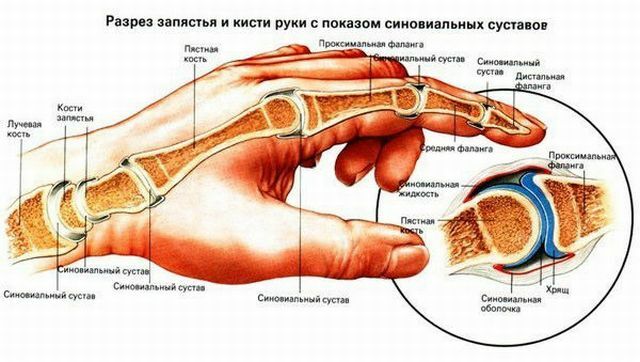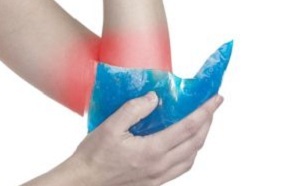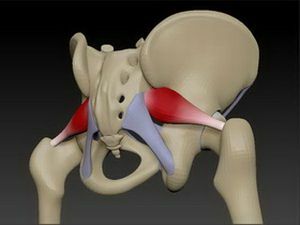 Pear-shaped muscle syndrome - is a kind of pain syndrome caused by the pinch of the sciatic nerve due to spasm of pear-shaped muscle.
Pear-shaped muscle syndrome - is a kind of pain syndrome caused by the pinch of the sciatic nerve due to spasm of pear-shaped muscle.
Spasm leads to a shortening and tightening of the muscle fibers, this limits the rotational movements of the thigh, painful sensations spread to the groin, leg to the knee, to the lumbar region.
This neurotrophic spasm is caused by irritation of the first sacral spine of the spinal cord nerve.
Article Contents
- avilable piriformis
- Causes syndrome
- Primary
- Secondary
- Vertebrogenic
- Nevertebrogennye
- Symptoms of inherent syndrome
- Local symptoms
- Signs of compression of the sciatic nerve
- signs of compression of the arteries and blood vessels
- Diagnostics syndrome
- Principles of treatment
- Medication
- Chiropractic
- Physiotherapy
- Reflex methods
- Pear-shaped blockade
- AnthemComplications-terrorist exercises
- Preventive measures
- Video: Recommendations for patients with piriformis syndrome
avilable piriformis muscle
has a triangular shape. One vertex is fastened to a large trochanter in the area of its apex by a tendon, then passes through a large sciatic foramen and is fastened by three uniform bundles to the sacrum, between the first and fourth sacral orifices.
Above the muscle there is a capsule of the sacroiliac joint, and beneath it is the anterior surface of the sacro-ligamentous ligament. Together with the muscle, a bundle of vessels and a sciatic nerve pass through the sciatic hole.
Pear-shaped muscle is needed to provide the following functions:
- rotational thigh movements in the outer direction;
- habilization of the hip joint;
- for holding the head of the femur inside the swivel cavity;
- for making leans forward, with fixed lower limbs.
Causes of the syndrome
The spectrum of the causes of this pain syndrome is very wide. It is accepted to group the causes by the direct source of the syndrome.
Primary
For primary causes of pear-shaped muscle syndrome, the stimulus is applied directly to the muscle:
- Trauma in the gluteal or lumbar region of the ( injury can cause hematoma, damage to the muscle tissue, which in turn will lead to irritation of the spinal cord nerve root).
- Stretching or strong strain of pear-shaped muscle .Often with excessive physical exertion, or as a result of sudden changes in position.
- Myositis of muscle .Inflammatory process can cause a sharp pain syndrome.
- Subcooling .When exposed to cold, the muscle shrinks much more, trying to generate as much ATP as possible. Such intensity can lead to overstrain of the muscle.
- As a result of an unsuccessfully injected injection. The nerve root can be touched.
Secondary
Causes indirectly affecting the muscle, but nonetheless leading to the onset of the syndrome: 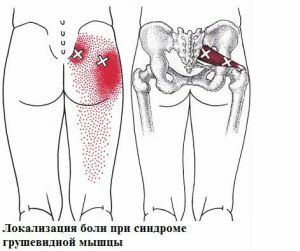
- Pathology of the pelvic organs .Inflammation can spread to a number of located organs, including muscles.
- For violations in the connective structures of the sacrum and the ilium.
Another classification of causes takes into account the relationship to the spinal column.
Vertebrogenic
- if the cause is directly or indirectly related to parts of the spine;
- trauma of the spinal cord, spine, etc;
- narrowing of intervertebral foramen;
- development of tumor formations on parts of the spine;
- manifestations of radiculitis in the lumbar spine.
Nonvertebrate
- pathological processes of internal organs occur;
- is broken the functioning of the muscular apparatus of this area.
Symptoms inherent in the syndrome
The manifestations of this syndrome can be either local( painful sensations arise in the immediate vicinity of the pear-shaped muscle, are localized in a certain area, associated with spasmodic phenomena in the muscle).
In the case when the symptoms indicate a violation of the innervation of certain parts, they speak of signs of squeezing the sciatic nerve. And if the violations are of the nature of insufficient nutrition of the organs, then these symptoms of pear-shaped muscle syndrome are classified as signs of compression of arteries and vessels.
Local symptoms
Local symptoms include:
- Pain sensations in the gluteal region of the , either in the sacroiliac joint or in the hip joint. Painful sensations are enhanced by movements in which the pear-shaped muscle takes part.
- Symptom to Bonne-Bobrovnikova. It is a complete relaxation of the gluteus muscle, in this condition it is possible to probe the densified pear-shaped muscle, with pain it arises.
- Symptom Vilenkina - when tapping in the region of the pear-shaped muscle, pain occurs.
When touched, the soreness of the ischium is felt.
Signs of compression of the sciatic nerve
the sciatic nerve innervates many structures of the lower limb, then its pinching breaks their functions:
- the spread of pain along the entire leg;
- pain is accompanied by a feeling of stinging , burning sensation;
- symptom may become oppression of the Achilles reflex ;

- if the fibers forming the tibial nerve are restrained, the pain is localized in the biceps muscle of the lower leg.
Symptoms of compression of arteries and vessels
- arises numbness of the fingers of the lower limb;
- blurred skin ;
- there are bouts of lameness , forcing to stop the movement and after a while at rest the blood flow is restored and again possible movement.
Diagnosis of
Syndrome As soon as a patient enters the doctor's office for diagnosis, the latter marks gait, posture and characteristic movements.
For a reliable diagnosis of pear-shaped muscle syndrome, the patient undergoes a number of studies. Among them:
- is checked for the presence of the Bonnet-Bobrovnikova symptom.
- Knocks a leg for the symptom of a Vilenkin .
- Tap on the lower lumbar or upper sacral spinous processes. In the case of contraction of the gluteus muscle, there is a positive symptom of Grossman .
- is carried out palpation of the attachment sites of the pear-shaped muscle - the region of the large trochanter of the femur and the sacroiliac joint. Positive result - the emergence of pain.
- Testing of the condition of the iliac sac and sacro-spine cord .
- As a diagnostic method, transrectal palpation of the pear-shaped muscle is used. In the event that the muscle is determined to be elastic and painful, the result is considered positive.
- Exclusion method .Directly into the pear-shaped muscle is injected an anesthetic solution( its form depends on individual tolerability), and if pain symptoms disappear, draw conclusions about the presence of pear-shaped muscle syndrome.
If there is a suspicion of the presence of this syndrome as a concomitant disease( oncology, trauma of the spine), specific instrumental methods are prescribed:
- computed tomography;
- X-ray examination of the of the lumbosacral spine;
- radioisotope scanning of ( in case of suspected presence of tumor formations).
 If you need to know which causes of neck pain are most often detected, you can find out the details in our article.
If you need to know which causes of neck pain are most often detected, you can find out the details in our article.
What you need to know is that first aid with an ankle dislocation does not cause a worsening of the trauma and facilitates further treatment, you can find out here.
Principles of treatment of
All treatment methods for pear-shaped muscle syndrome that are used should be aimed at treating the causes of this pain syndrome. Treatment is always systemic and complex.
Medicated
Drug treatment of pear-shaped muscle syndrome includes:
- for relaxing, reducing pain syndromes are introduced muscle relaxants;
- non-steroidal anti-inflammatory drugs;
- analgesics with strong pain;
- preparations to improve blood circulation. Reduce inflammation, help in resuming innervation.
Manual therapy
The procedure is developed individually. Often applicable are:
- post-isometric muscle relaxation;
- postresiprochnaya relaxation of muscles.
Physiotherapy
Basic physiotherapy procedures include:
- Magnetic-Laser Therapy;
- electrophoresis.
Reflex methods
Among the main:
- laser acupuncture;
- vacuum therapy;
- pharmacotherapy;
- acupuncture and others;
- therapeutic massage.
Blockade of pear-shaped muscle
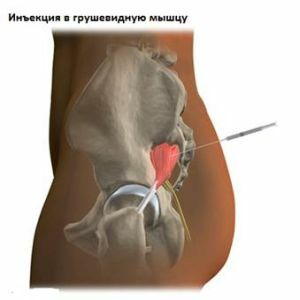 In the event that the strain of the pear-shaped muscle lasts a rather long period of time, causing a whole series of troubles, the blockade of the muscle with an anesthetic is carried out as part of the treatment.
In the event that the strain of the pear-shaped muscle lasts a rather long period of time, causing a whole series of troubles, the blockade of the muscle with an anesthetic is carried out as part of the treatment.
For this, in the prone position, three main points are marked: the ischial tuber, the top of the large trochanter and the posterior-superior iliac bone and are joined in the form of a triangle. From the last point, draw a line so that the angle is divided into two equal parts. This line is conventionally divided into three parts and marks the border of the lower and middle parts.
In this area, a local anesthetic of the connective tissues is made, after which the needle is inserted so as to get into the abdomen of the pear-shaped muscle. An anesthetic is injected.
Exercise exercises
You can relax the muscle, relieve pain and restore proper motor activity with the help of physical exercises.
- Knees move towards each other and in different directions .Performed smoothly, lying on the back, knees in the n
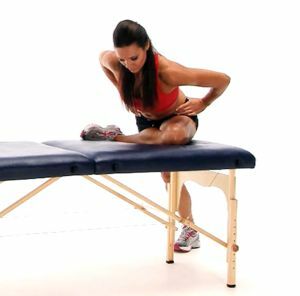
In the photo one of the effective exercises in the syndrome of the pear-shaped muscle
is an olfactory state.
- Without changing the position, the perform shaking unidirectional movements with closed knees.
- Movement for getting up. From sitting position, with closed knees and widely divorced feet moving upwards, helping first by hand, resting on the seat, and after a detachment of the hand, with the help of the partner to complete the climb.
All individual exercises will help to make a physiotherapist, taking into account age, weight, physical form and at each stage of treatment.
Complications of
Timely untreated, the syndrome can lead to the following consequences:
- The functioning of the muscles of the of the lower extremity is disrupted;
- Appears signs of degradation of ligaments and joint function;
- has problems with pelvic organs .
Preventative measures
Some measures will avoid prolonged rehabilitation, and costly treatment. This is especially true for people who are prone to lumbar disease:
- should avoid excessive physical exertion;
- attentive to health( at the first signs of sciatica seek help);
- to avoid hypothermia;
- try not to be in the same position for a long time, despite its comfort.
The appearance of pear-shaped muscle syndrome is always accompanied by a number of uncomfortable sensations, but qualitative diagnostics will allow timely treatment and minimize manifestations until complete recovery.

